
March 5, 2019 Vanguard Natural Resources, Inc. 5847 San Felipe, Suite 3000 Houston, Texas 77057 Re: Vanguard Natural Resources, Inc. Audit of Proved Developed Reserves As of December 31, 2018 SEC Reserves Case Ladies and Gentlemen: At your request, Miller and Lents, Ltd. (M&L) performed an audit of the estimates of proved developed reserves attributable to interests owned by Vanguard Natural Resources, Inc. (VNR) in certain oil and gas properties as of December 31, 2018. This audit report was prepared for the use of VNR in its annual financial and reserves reporting and was completed on January 25, 2019. VNR’s estimates, shown below, are in accordance with the definitions contained in Securities and Exchange Commission (SEC) Regulation S X, Rule 4-10(a) as shown in the Appendix. Reserves as of December 31, 2018 Net Reserves Oil and Gas Cond. Gas NGL Equivalent Reserves Category MBBL MMCF MBBL MMCFE Prov ed Dev eloped Producing 32,290 677,410 28,883 1,044,449 Prov ed Dev eloped Nonproducing 2,430 11,944 1,082 33,016 Total Proved 34,721 689,354 29,965 1,077,465 Oil and NGL volumes are expressed in thousand barrels (MBBL). Gas volumes are expressed in million cubic feet (MMCF). Gas Equivalent volumes are expressed in million cubic feet equivalent (MMCFE). Oil and NGL volumes expressed in MBBL are equal to an energy equivalent of six MMCF of Gas. M&L prepared independent estimates of 100 percent of the proved reserves reported by VNR. Based on M&L’s investigations and subject to the limitations described hereinafter, it is M&L’s judgment that (1) the reserves estimation methods employed by VNR were appropriate, and its classification of such reserves was appropriate to the relevant SEC reserve definitions, (2) its reserves estimation processes were comprehensive and of sufficient depth, (3) the data upon which VNR relied were adequate and of sufficient quality, and (4) the results of those estimates and projections are, in the aggregate, reasonable with a difference of less than 10 percent when compared on the basis of net gas equivalent.
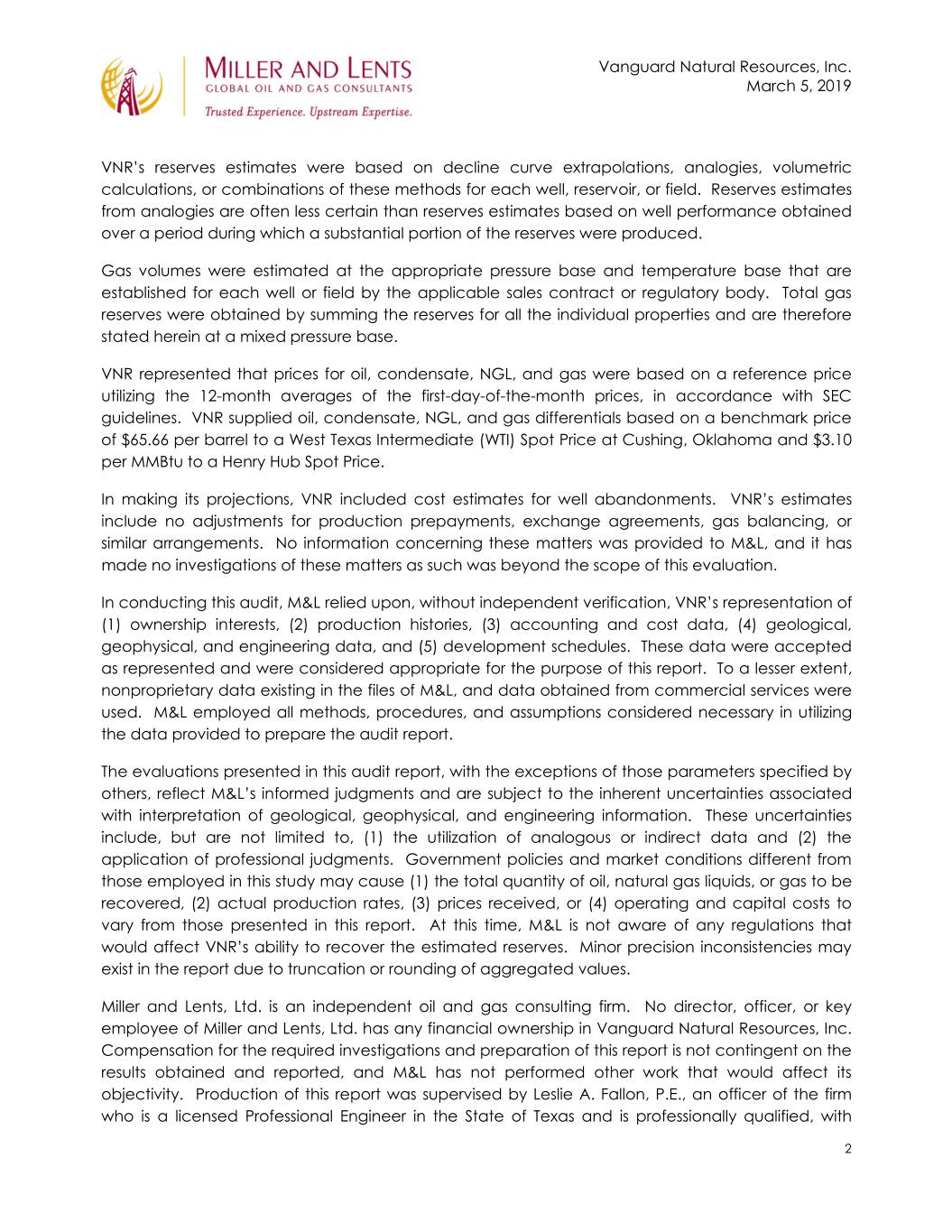
Vanguard Natural Resources, Inc. March 5, 2019 VNR’s reserves estimates were based on decline curve extrapolations, analogies, volumetric calculations, or combinations of these methods for each well, reservoir, or field. Reserves estimates from analogies are often less certain than reserves estimates based on well performance obtained over a period during which a substantial portion of the reserves were produced. Gas volumes were estimated at the appropriate pressure base and temperature base that are established for each well or field by the applicable sales contract or regulatory body. Total gas reserves were obtained by summing the reserves for all the individual properties and are therefore stated herein at a mixed pressure base. VNR represented that prices for oil, condensate, NGL, and gas were based on a reference price utilizing the 12-month averages of the first-day-of-the-month prices, in accordance with SEC guidelines. VNR supplied oil, condensate, NGL, and gas differentials based on a benchmark price of $65.66 per barrel to a West Texas Intermediate (WTI) Spot Price at Cushing, Oklahoma and $3.10 per MMBtu to a Henry Hub Spot Price. In making its projections, VNR included cost estimates for well abandonments. VNR’s estimates include no adjustments for production prepayments, exchange agreements, gas balancing, or similar arrangements. No information concerning these matters was provided to M&L, and it has made no investigations of these matters as such was beyond the scope of this evaluation. In conducting this audit, M&L relied upon, without independent verification, VNR’s representation of (1) ownership interests, (2) production histories, (3) accounting and cost data, (4) geological, geophysical, and engineering data, and (5) development schedules. These data were accepted as represented and were considered appropriate for the purpose of this report. To a lesser extent, nonproprietary data existing in the files of M&L, and data obtained from commercial services were used. M&L employed all methods, procedures, and assumptions considered necessary in utilizing the data provided to prepare the audit report. The evaluations presented in this audit report, with the exceptions of those parameters specified by others, reflect M&L’s informed judgments and are subject to the inherent uncertainties associated with interpretation of geological, geophysical, and engineering information. These uncertainties include, but are not limited to, (1) the utilization of analogous or indirect data and (2) the application of professional judgments. Government policies and market conditions different from those employed in this study may cause (1) the total quantity of oil, natural gas liquids, or gas to be recovered, (2) actual production rates, (3) prices received, or (4) operating and capital costs to vary from those presented in this report. At this time, M&L is not aware of any regulations that would affect VNR’s ability to recover the estimated reserves. Minor precision inconsistencies may exist in the report due to truncation or rounding of aggregated values. Miller and Lents, Ltd. is an independent oil and gas consulting firm. No director, officer, or key employee of Miller and Lents, Ltd. has any financial ownership in Vanguard Natural Resources, Inc. Compensation for the required investigations and preparation of this report is not contingent on the results obtained and reported, and M&L has not performed other work that would affect its objectivity. Production of this report was supervised by Leslie A. Fallon, P.E., an officer of the firm who is a licensed Professional Engineer in the State of Texas and is professionally qualified, with 2
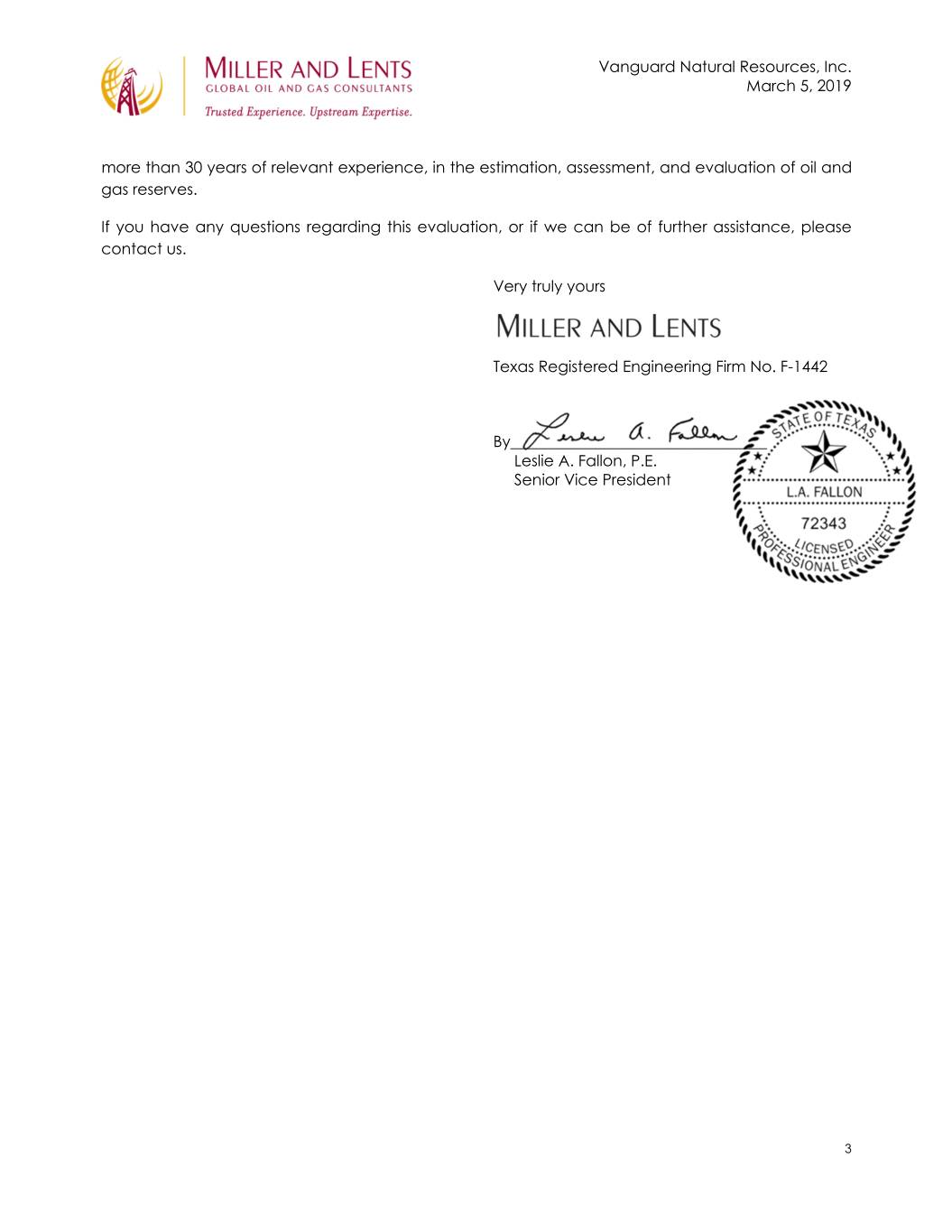
Vanguard Natural Resources, Inc. March 5, 2019 more than 30 years of relevant experience, in the estimation, assessment, and evaluation of oil and gas reserves. If you have any questions regarding this evaluation, or if we can be of further assistance, please contact us. Very truly yours Texas Registered Engineering Firm No. F-1442 By_________________________________ Leslie A. Fallon, P.E. Senior Vice President 3
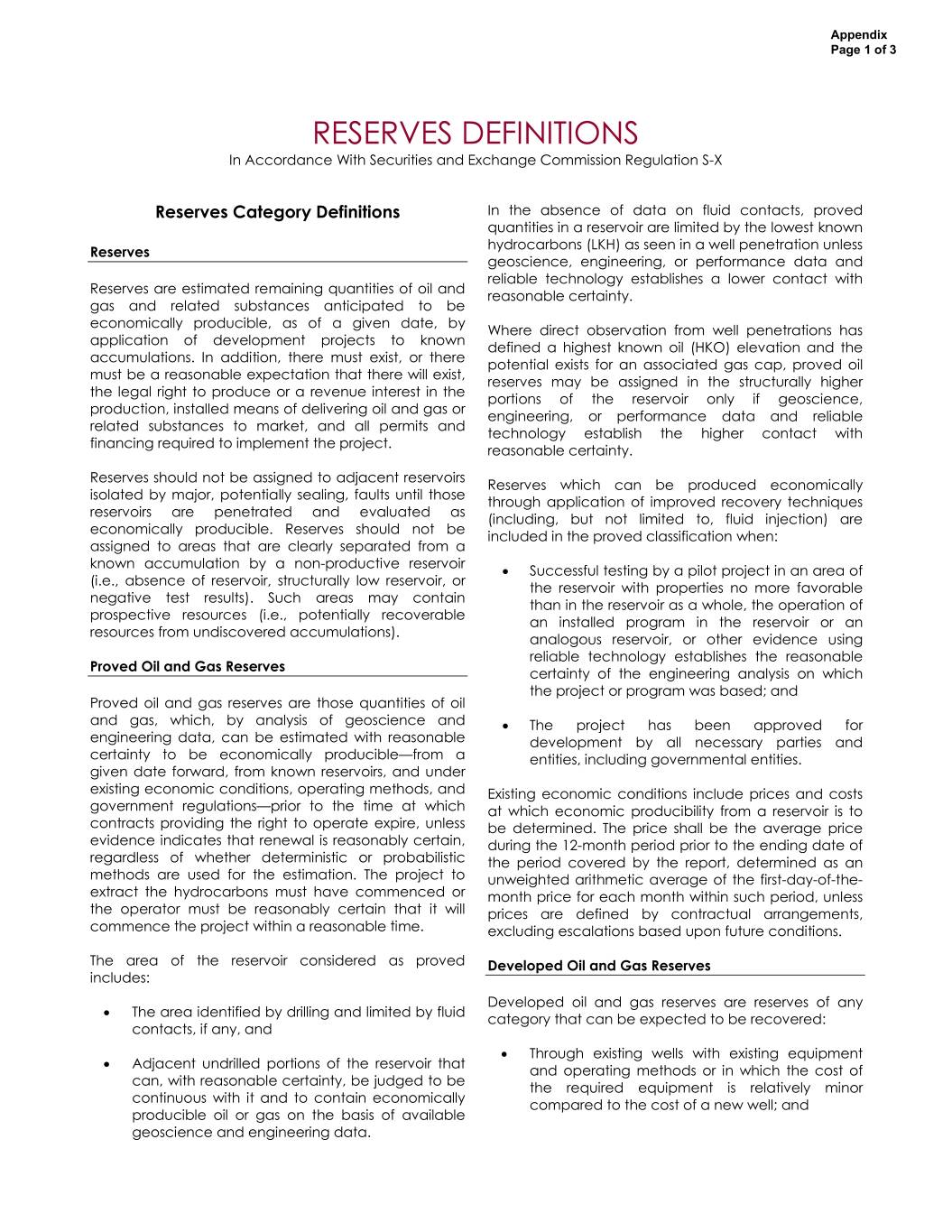
Appendix Page 1 of 3 RESERVES DEFINITIONS In Accordance With Securities and Exchange Commission Regulation S-X Reserves Category Definitions In the absence of data on fluid contacts, proved quantities in a reservoir are limited by the lowest known hydrocarbons (LKH) as seen in a well penetration unless Reserves geoscience, engineering, or performance data and reliable technology establishes a lower contact with Reserves are estimated remaining quantities of oil and reasonable certainty. gas and related substances anticipated to be economically producible, as of a given date, by Where direct observation from well penetrations has application of development projects to known defined a highest known oil (HKO) elevation and the accumulations. In addition, there must exist, or there potential exists for an associated gas cap, proved oil must be a reasonable expectation that there will exist, reserves may be assigned in the structurally higher the legal right to produce or a revenue interest in the portions of the reservoir only if geoscience, production, installed means of delivering oil and gas or engineering, or performance data and reliable related substances to market, and all permits and technology establish the higher contact with financing required to implement the project. reasonable certainty. Reserves should not be assigned to adjacent reservoirs Reserves which can be produced economically isolated by major, potentially sealing, faults until those through application of improved recovery techniques reservoirs are penetrated and evaluated as (including, but not limited to, fluid injection) are economically producible. Reserves should not be included in the proved classification when: assigned to areas that are clearly separated from a known accumulation by a non-productive reservoir Successful testing by a pilot project in an area of (i.e., absence of reservoir, structurally low reservoir, or the reservoir with properties no more favorable negative test results). Such areas may contain than in the reservoir as a whole, the operation of prospective resources (i.e., potentially recoverable an installed program in the reservoir or an resources from undiscovered accumulations). analogous reservoir, or other evidence using reliable technology establishes the reasonable Proved Oil and Gas Reserves certainty of the engineering analysis on which the project or program was based; and Proved oil and gas reserves are those quantities of oil and gas, which, by analysis of geoscience and The project has been approved for engineering data, can be estimated with reasonable development by all necessary parties and certainty to be economically producible—from a entities, including governmental entities. given date forward, from known reservoirs, and under existing economic conditions, operating methods, and Existing economic conditions include prices and costs government regulations—prior to the time at which at which economic producibility from a reservoir is to contracts providing the right to operate expire, unless be determined. The price shall be the average price evidence indicates that renewal is reasonably certain, during the 12-month period prior to the ending date of regardless of whether deterministic or probabilistic the period covered by the report, determined as an methods are used for the estimation. The project to unweighted arithmetic average of the first-day-of-the- extract the hydrocarbons must have commenced or month price for each month within such period, unless the operator must be reasonably certain that it will prices are defined by contractual arrangements, commence the project within a reasonable time. excluding escalations based upon future conditions. The area of the reservoir considered as proved Developed Oil and Gas Reserves includes: Developed oil and gas reserves are reserves of any The area identified by drilling and limited by fluid category that can be expected to be recovered: contacts, if any, and Through existing wells with existing equipment Adjacent undrilled portions of the reservoir that and operating methods or in which the cost of can, with reasonable certainty, be judged to be the required equipment is relatively minor continuous with it and to contain economically compared to the cost of a new well; and producible oil or gas on the basis of available geoscience and engineering data.
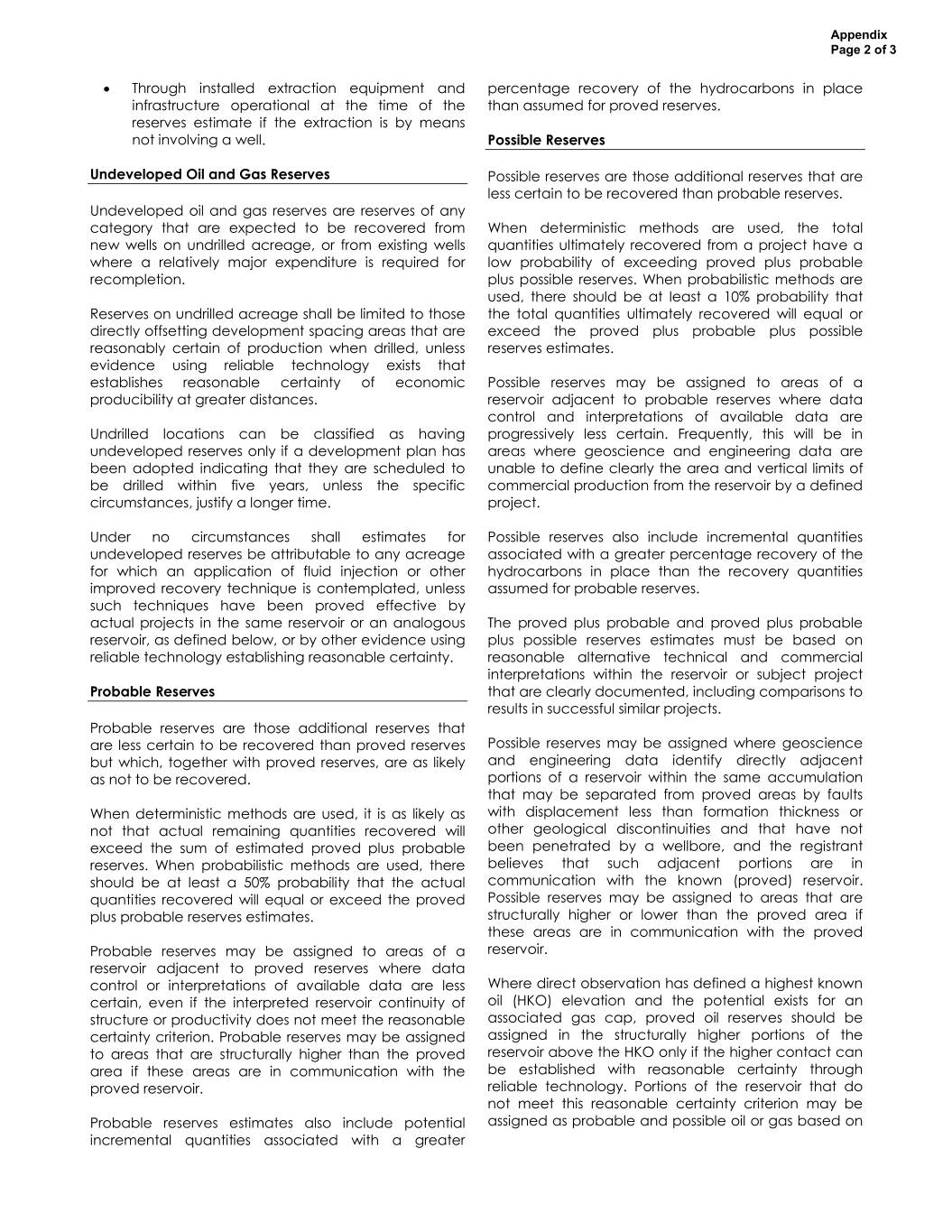
Appendix Page 2 of 3 Through installed extraction equipment and percentage recovery of the hydrocarbons in place infrastructure operational at the time of the than assumed for proved reserves. reserves estimate if the extraction is by means not involving a well. Possible Reserves Undeveloped Oil and Gas Reserves Possible reserves are those additional reserves that are less certain to be recovered than probable reserves. Undeveloped oil and gas reserves are reserves of any category that are expected to be recovered from When deterministic methods are used, the total new wells on undrilled acreage, or from existing wells quantities ultimately recovered from a project have a where a relatively major expenditure is required for low probability of exceeding proved plus probable recompletion. plus possible reserves. When probabilistic methods are used, there should be at least a 10% probability that Reserves on undrilled acreage shall be limited to those the total quantities ultimately recovered will equal or directly offsetting development spacing areas that are exceed the proved plus probable plus possible reasonably certain of production when drilled, unless reserves estimates. evidence using reliable technology exists that establishes reasonable certainty of economic Possible reserves may be assigned to areas of a producibility at greater distances. reservoir adjacent to probable reserves where data control and interpretations of available data are Undrilled locations can be classified as having progressively less certain. Frequently, this will be in undeveloped reserves only if a development plan has areas where geoscience and engineering data are been adopted indicating that they are scheduled to unable to define clearly the area and vertical limits of be drilled within five years, unless the specific commercial production from the reservoir by a defined circumstances, justify a longer time. project. Under no circumstances shall estimates for Possible reserves also include incremental quantities undeveloped reserves be attributable to any acreage associated with a greater percentage recovery of the for which an application of fluid injection or other hydrocarbons in place than the recovery quantities improved recovery technique is contemplated, unless assumed for probable reserves. such techniques have been proved effective by actual projects in the same reservoir or an analogous The proved plus probable and proved plus probable reservoir, as defined below, or by other evidence using plus possible reserves estimates must be based on reliable technology establishing reasonable certainty. reasonable alternative technical and commercial interpretations within the reservoir or subject project Probable Reserves that are clearly documented, including comparisons to results in successful similar projects. Probable reserves are those additional reserves that are less certain to be recovered than proved reserves Possible reserves may be assigned where geoscience but which, together with proved reserves, are as likely and engineering data identify directly adjacent as not to be recovered. portions of a reservoir within the same accumulation that may be separated from proved areas by faults When deterministic methods are used, it is as likely as with displacement less than formation thickness or not that actual remaining quantities recovered will other geological discontinuities and that have not exceed the sum of estimated proved plus probable been penetrated by a wellbore, and the registrant reserves. When probabilistic methods are used, there believes that such adjacent portions are in should be at least a 50% probability that the actual communication with the known (proved) reservoir. quantities recovered will equal or exceed the proved Possible reserves may be assigned to areas that are plus probable reserves estimates. structurally higher or lower than the proved area if these areas are in communication with the proved Probable reserves may be assigned to areas of a reservoir. reservoir adjacent to proved reserves where data control or interpretations of available data are less Where direct observation has defined a highest known certain, even if the interpreted reservoir continuity of oil (HKO) elevation and the potential exists for an structure or productivity does not meet the reasonable associated gas cap, proved oil reserves should be certainty criterion. Probable reserves may be assigned assigned in the structurally higher portions of the to areas that are structurally higher than the proved reservoir above the HKO only if the higher contact can area if these areas are in communication with the be established with reasonable certainty through proved reservoir. reliable technology. Portions of the reservoir that do not meet this reasonable certainty criterion may be Probable reserves estimates also include potential assigned as probable and possible oil or gas based on incremental quantities associated with a greater
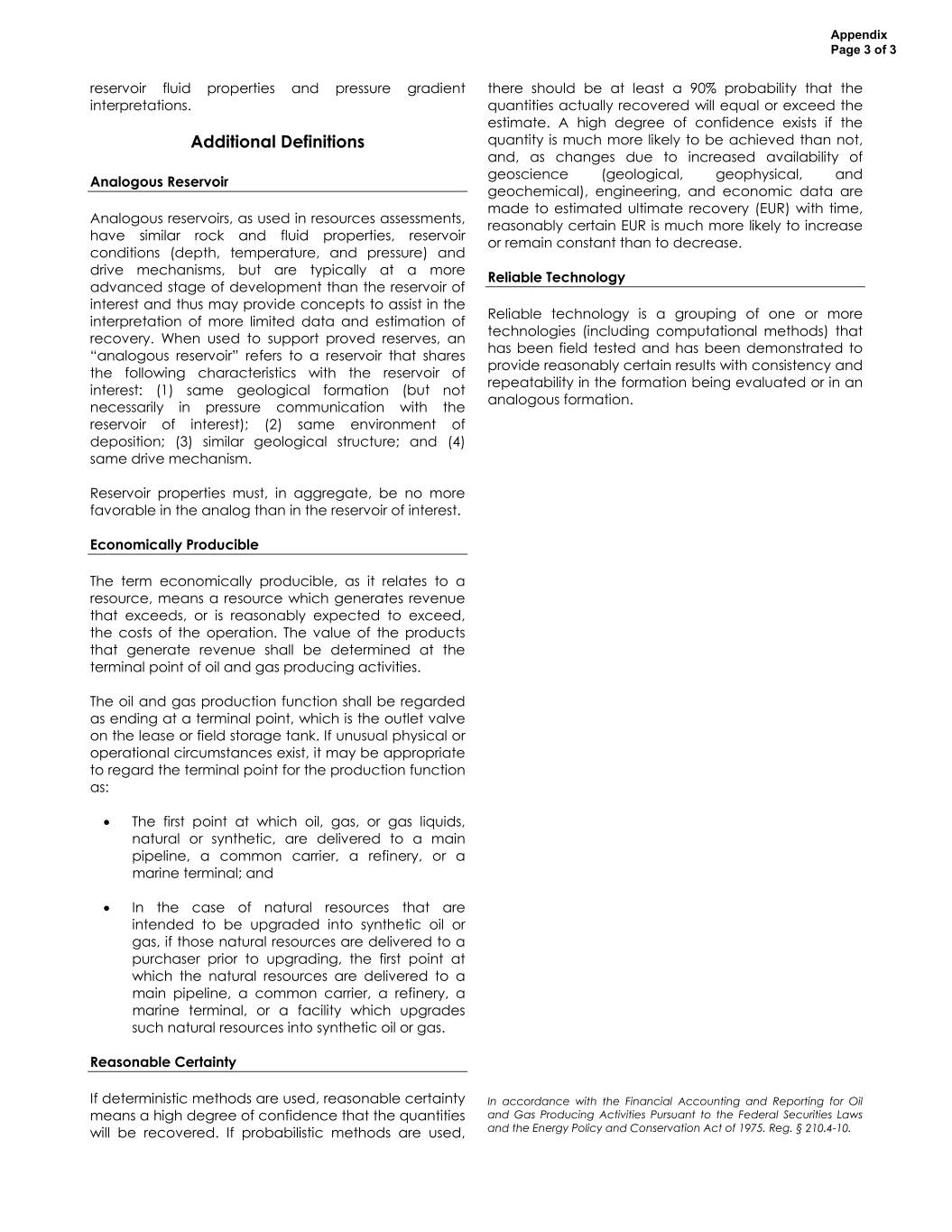
Appendix Page 3 of 3 reservoir fluid properties and pressure gradient there should be at least a 90% probability that the interpretations. quantities actually recovered will equal or exceed the estimate. A high degree of confidence exists if the Additional Definitions quantity is much more likely to be achieved than not, and, as changes due to increased availability of geoscience (geological, geophysical, and Analogous Reservoir geochemical), engineering, and economic data are made to estimated ultimate recovery (EUR) with time, Analogous reservoirs, as used in resources assessments, reasonably certain EUR is much more likely to increase have similar rock and fluid properties, reservoir or remain constant than to decrease. conditions (depth, temperature, and pressure) and drive mechanisms, but are typically at a more Reliable Technology advanced stage of development than the reservoir of interest and thus may provide concepts to assist in the Reliable technology is a grouping of one or more interpretation of more limited data and estimation of technologies (including computational methods) that recovery. When used to support proved reserves, an has been field tested and has been demonstrated to “analogous reservoir” refers to a reservoir that shares provide reasonably certain results with consistency and the following characteristics with the reservoir of repeatability in the formation being evaluated or in an interest: (1) same geological formation (but not analogous formation. necessarily in pressure communication with the reservoir of interest); (2) same environment of deposition; (3) similar geological structure; and (4) same drive mechanism. Reservoir properties must, in aggregate, be no more favorable in the analog than in the reservoir of interest. Economically Producible The term economically producible, as it relates to a resource, means a resource which generates revenue that exceeds, or is reasonably expected to exceed, the costs of the operation. The value of the products that generate revenue shall be determined at the terminal point of oil and gas producing activities. The oil and gas production function shall be regarded as ending at a terminal point, which is the outlet valve on the lease or field storage tank. If unusual physical or operational circumstances exist, it may be appropriate to regard the terminal point for the production function as: The first point at which oil, gas, or gas liquids, natural or synthetic, are delivered to a main pipeline, a common carrier, a refinery, or a marine terminal; and In the case of natural resources that are intended to be upgraded into synthetic oil or gas, if those natural resources are delivered to a purchaser prior to upgrading, the first point at which the natural resources are delivered to a main pipeline, a common carrier, a refinery, a marine terminal, or a facility which upgrades such natural resources into synthetic oil or gas. Reasonable Certainty If deterministic methods are used, reasonable certainty In accordance with the Financial Accounting and Reporting for Oil means a high degree of confidence that the quantities and Gas Producing Activities Pursuant to the Federal Securities Laws will be recovered. If probabilistic methods are used, and the Energy Policy and Conservation Act of 1975. Reg. § 210.4-10.





